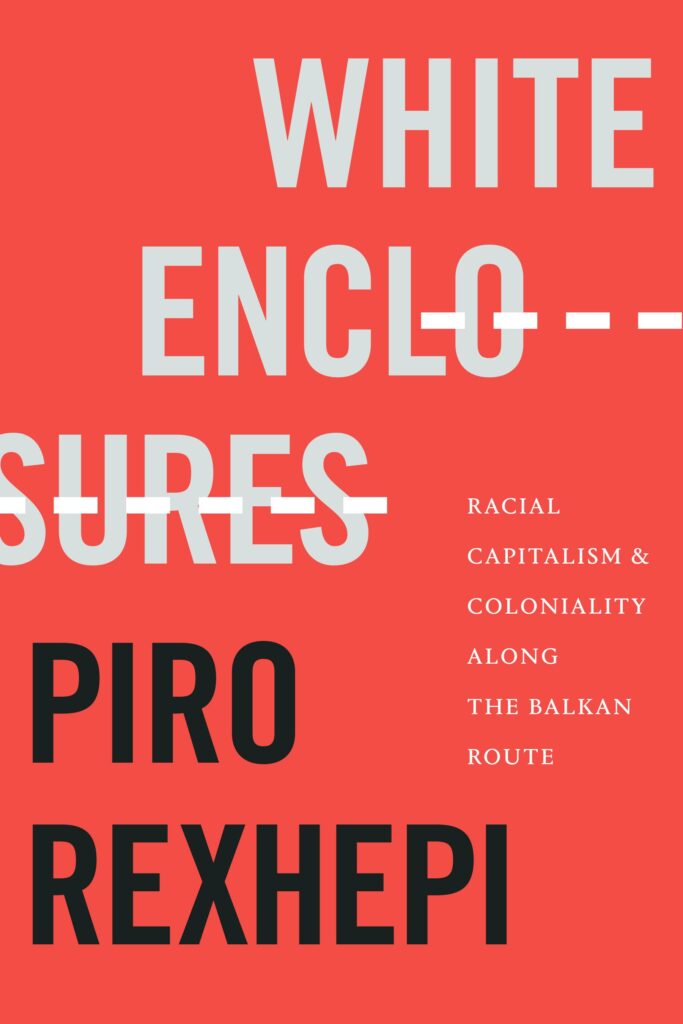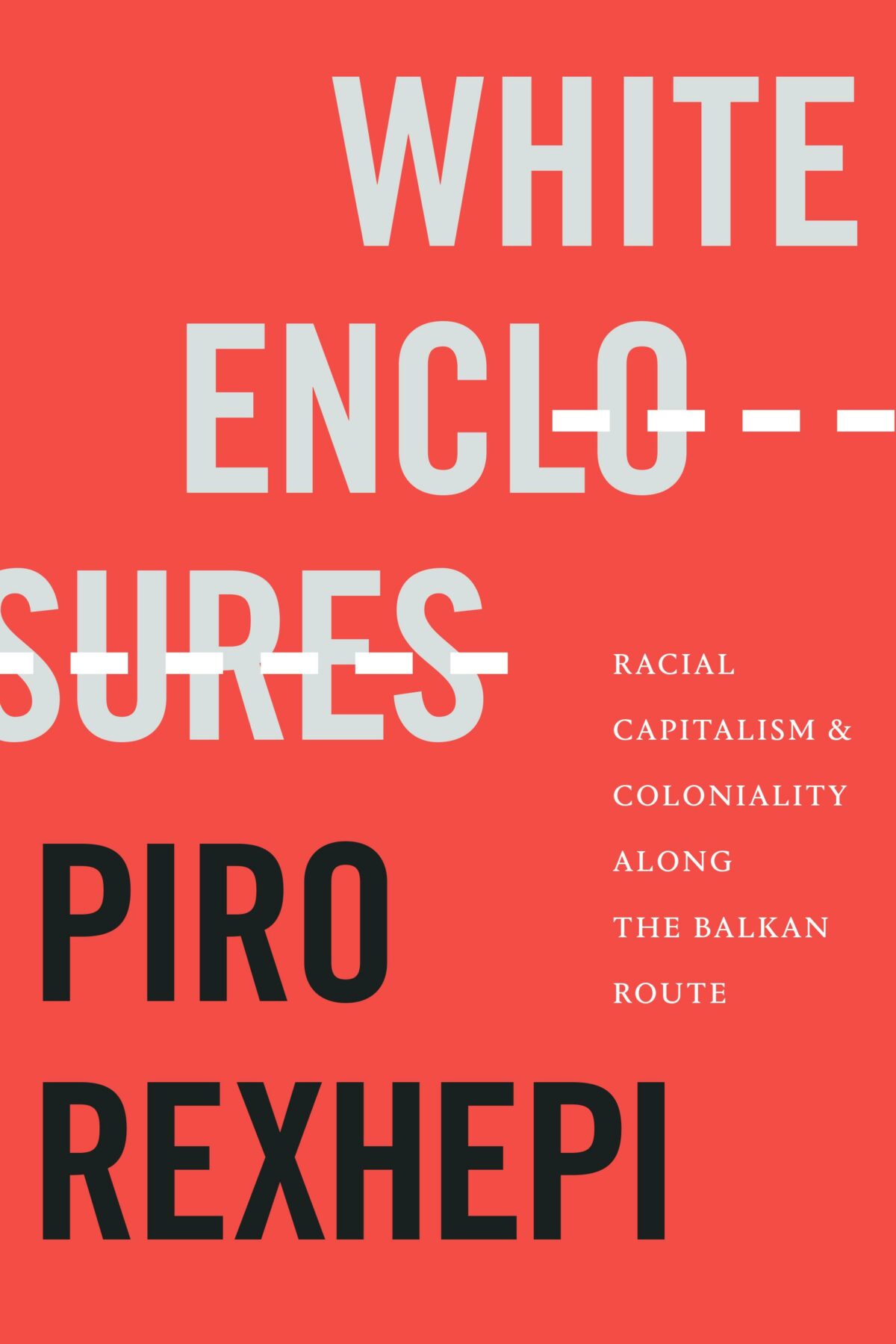Piro Rexhepi’s book White Enclosures: Racial Capitalism and Coloniality along the Balkan Route (Duke University Press 2022) is a refreshing study that goes beyond current global queerphobic and racist tendencies and focuses on largely overlooked Bosnian, Albanian, and Roma Muslim lived experiences.

In 2015, ‘Balkan route’ became a buzzword for war refugees predominantly from Syria who set out on the deadly path to Fortress Europe. The Visegrád group – made up of the Czech Republic, Hungary, Poland, and Slovakia – was only marginally affected, but it was in these states that perhaps the most vocal representatives of an anti-migrant stance could be found. Slogans such as “Slovakia is not Africa!” at a rally in Bratislava in September 2015 were one of the clearest expressions of this attitude. This has not escaped the notice of international observers, who tend to consider themselves as impartial experts on political events in Eastern Europe. While media pundits in Germany and France took pains to explain this form of racism, these articles did not include examples of how leftist movements or organisations in these countries tried to counteract the social acceptance of racial discrimination.
This points to a political climate in Eastern Europe in which the conceptualisation of racism has been neglected – even among the left. Here, two attitudes in particular have prevailed: either to consider “race” as “an outcome of capitalist exploitation” or to shift the discussion of racism to questions of socialist modernisation “where colonial institutionalized hierarchies of race go to hide their tracks,” writes Piro Rexhepi in his new book White Enclosures: Racial Capitalism and Coloniality along the Balkan Route, published with Duke University Press in December 2022.
It is surprising that the region is still not considered a global setting of racialisation and coloniality in mainstream scholarly debates, although the influence of intersecting empires – be it Russian, Habsburg, or Ottoman – is unmistakable in the modern history of this geopolitical space. For this reason, White Enclosures: Racial Capitalism and Coloniality along the Balkan Route by Piro Rexhepi makes a unique contribution by theorising the Balkans as a European borderland zone from a decolonial/postcolonial perspective. Therefore, his book can be put into conversation with the work of researchers like Alyosxa Tudor and Madina Tlostanova, who have studied other Eastern European peripheries from this angle. Two other aspects underline the innovation of his research: Firstly, Rexhepi centres Bosnian, Albanian, and Roma Muslim lived experiences – populations that tend to be largely ignored in academic knowledge productions on Eastern Europe. Secondly, this monograph is enriched by its focus on sexuality. By centering queer Albanian and Roma Muslimness, he not only manages to connect the books’ geopolitical dimension with the bodily experienced one. In this way, he also accentuates these “voices of marginality” to create “an actual and imagined futurity” (p. 149) that goes beyond the current global queerphobic and racist tendencies.
Writing from a bird’s eye view
As the focus of Eastern European studies remains on Slavic and Christian subjectivities, the history of the Muslim-majority populations in the region is largely unknown even to an academic audience. Therefore, Piro Rexhepi faced the challenge of presenting his findings in such a way that even those who are not familiar with the history of Muslims in the Balkans can follow his stream of thought in White Enclosures.
Here one could opt for the strategy of explaining all historical details relevant for one’s analysis – like Noel Ignatiev did in his 1995 seminal book How the Irish Became White. The risk in this approach is that the historical knowledge provided can be so insular that it offers only little insights to readers with no general overview of the history of the subjects studied. That was my experience after reading this book, which, like Rexhepi’s work, explores the role that an oppressed but largely overlooked European population plays in the global hierarchies of whiteness – in Ignatiev’s case, the Irish.
Piro Rexhepi has found another solution to this hurdle in White Enclosures, which could be described as writing from a bird’s eye view. For instance, he does not react to the established Eurocentric historiographies by trying to prove the relevance of Muslims in Eastern Europe. Instead, he has chosen to address the gaps that are obviously present when thinking about the region from a postcolonial/decolonial perspective. An overview of the five chapters of the book illustrates quite well the issues that should be considered from this angle.
Coloniality and racial capitalism in the Balkans
Chapter one is about the situation of Muslims in Yugoslavia. Here, different Muslim identity formations (Bosnian, Albanian, Roma) and their relationship with other Muslims from the Third World during the Cold War are addressed. While Chapter two explores Bosniaks’ investment in whiteness as a socio-political construction, chapter three deals with the same question with regards to Albanians and highlights the differences and similarities between these two identity formations. Chapters four and five are sexuality-centred. Whereas the former deals with the role of sexuality as an instrument of race and empire making using the example of Albanians, the latter answers the same question for Roma Muslims in Bulgaria and also points out the structural racism to which they are exposed. This structure is so pedagogically valuable that it must be highlighted. In other words, even readers who have no historical knowledge of the Balkans or have never associated this European periphery with coloniality can get a lot out of reading White Enclosures.
Methodologically, Rexhepi’s book impresses with its coherent and well-dosed combination of discourse analysis and fieldwork. He traces the dominant discourses in the Balkans through relevant events in media, pop culture, and politics to theorise different aspects of coloniality and racial capitalism in the region. Chapters two and three on Bosnian and Albanian investments in whiteness are striking examples of this analytical approach.
In terms of fieldwork, Rexhepi’s interviews with the Bosnian intellectual Melika Salihbegović are worth emphasising as they are a good example of how to foreground marginalised voices without objectifying them for the purpose of academic knowledge production. These conversations, borne of mutual respect, are captivating for their empathy and depth, while Salihbegović’s life is not only emblematic of solidarities between Muslims going beyond Cold War classifications like second and third world, but also highlights discrimination against Muslims in Yugoslavia. By adding biographical (related to Salihbegović) and essayistic elements, these passages enrich White Enclosures stylistically without compromising the book’s scholarly conciseness. This becomes particularly clear in chapters one and two.
Postsocialism and postcolonialism
White Enclosures makes an important contribution to current academic debates on the relationship between postsocialism and postcolonialism in Eastern Europe. The book addresses “the postsocialist nostalgia appropriating postcolonial approaches” which in the extreme leads to the false analogy that postsocialism is more or less the postcolonialism of all populations affected by the fall of the Berlin Wall. One could argue that this represents a form of epistemic violence because this analogy “anesthetize[s] or directly disavow[s] the socialist-era structural racism,” as Rexhepi writes (p. 72). Moreover, this conflation renders “Muslims, Roma and migrants” impossible or unthinkable subjects in the region.
In recent years, academic conferences on postcolonialism and postsocialism have been organised all over Europe. I have attended three conferences of this kind in the last few years – Rijeka in 2015, Göttingen in 2016, and Dresden in 2019 – and have often gone home with the same feeling. It could happen that a senior scholar from a generic Eastern European positionality spoke about postcolonialism in the region in a way that was condescending to participants with minoritised positionalities. Although one sensed that there was something fundamentally wrong with the argument, one felt unable to formulate a response. Therefore, it can be claimed that White Enclosures brings to the table all the arguments that Eastern European scholars from minoritised positionalities would have needed at these academic events.
In examining actual colonialism in Eastern Europe, Rexhepi develops another argument rarely found in these discussions. Hungary, for example, had colonial encounters with Muslims in the Balkans when it colonised Bosnia and Herzegovina in 1878 as part of the Habsburg Empire alongside Austria. Citing numerous Serbian scholars, he explores the “settler colonization of Kosovo by the kingdom of Serbs, Croats, and Slovenes after the Balkan Wars [in 1912-13]” (p. 14). As far as Roma populations are concerned, it needs to be taken into account that “before, during, and after socialism” (p.14) they were constructed as subjects who did not belong to Europe and who “supposedly arrived together with the Ottomans” (p.14). These three examples show how “complex constellations of coloniality in former Eastern Europe” are linked to “European modern/colonial expansion” and had racialising impacts on the region’s Bosnian, Albanian, and Roma Muslims.
Azis, a famous queer Roma Muslim voice against homophobia and racism in Bulgaria
Rexhepi also deconstructs other aspects of European modernity. For example, he addresses the ‘Balkan route’ as a way to examine the region’s entanglement in racial capitalism. The current way the European Union (EU) deals with migrants has become “a growing industry that has bolstered its spending for border security from €5.6 billion ($6.3 billion) for 2014–2020 to €21.3 billion ($24 billion) for 2021–2027” (p. 5). The means used range from “wholesale surveillance and militarization,” “endless funding for migrant policing and violence,” “incarceration of communities of color,” to “sophisticated biometric and drone control” (p. 154). In White Enclosures, he explains the increasing brutality of this anti-migrant EU policy playing out in the Balkans as the attempt “to safeguard white supremacy in the face of disintegrating Euro-American coloniality/modernity” (p. 153).
In White Enclosures, sexuality plays a crucial role and is theorised in a way that always points to its interplay with other policing aspects of coloniality such as racism. Many fascinating passages of the book revolve around Azis, a Roma Muslim and queer singer in Bulgaria who “is heard in Belgrade and Beirut alike” (p. 27) and whose “music disturbs Bulgarian and Balkan racist and homophobic imaginaries.” What this representative of “queer and Chalga aesthetics” has in common with musicians like Božo Vrećo in Bosnia or Tallava artists in Kosovo is that he uncovers “what lurks in the deep unconsciousness of the Albanians, Muslims, Bosnians, and Roma that the secular, modern redemption offered seems unable to articulate yet represses from public debate” (p. 137).
When proximity to whiteness is a defining feature of an identity formation, it often seems impossible to take this identity formation as a starting point for imagining a different world. But with White Enclosures: Racial Capitalism and Coloniality along the Balkan Route Piro Rexhepi manages to do just that. This book not only challenges Bosnian and Albanian dominant political discourses, which for decades have refused to acknowledge the unequal power dynamics between the Balkan periphery and the European centre. It also is a long overdue book. For it takes these Muslim-majority populations, despite their closeness to whiteness, as a starting point for imagining a different world in which internationalist solidarity among the oppressed is possible.

Adem Ferizaj is a Ph.D. student at the Centre for Gender Studies at SOAS University of London. His dissertation is an epistemological study of the roles of Muslim-majority populations from the Balkans in the global hierarchies of whiteness.

